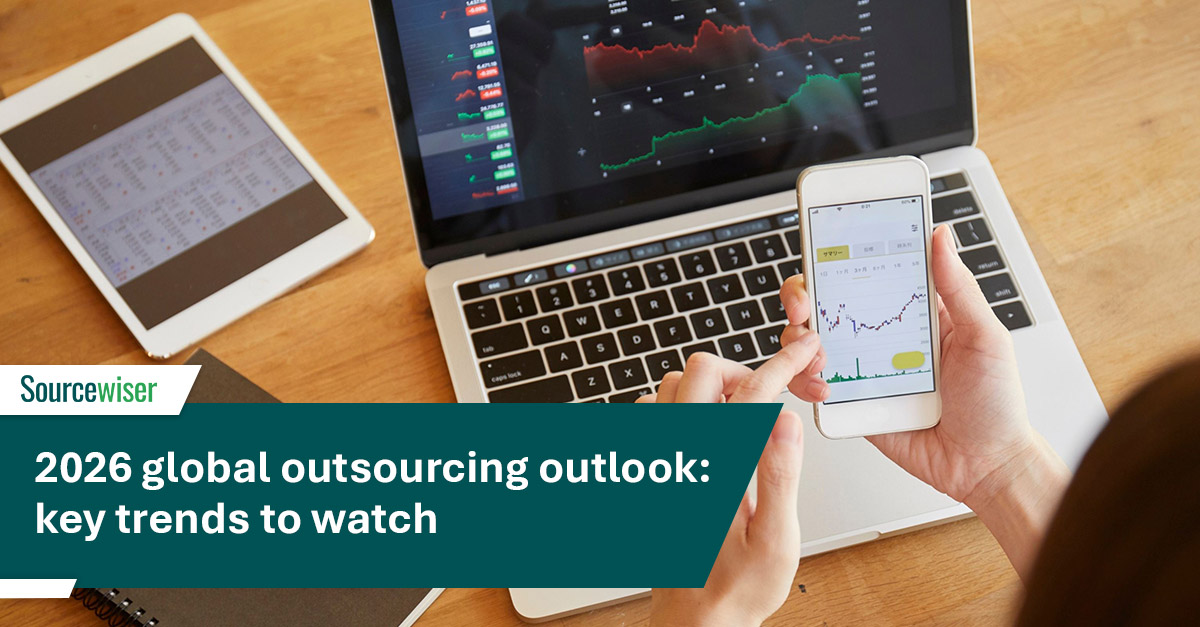Global outsourcing has evolved far beyond its origins as a cost-saving measure. In recent years, organisations have shifted from relying on a single sourcing model to adopting a more integrated approach that combines outsourcing, insourcing, global in-house centres (GICs), and digital workforce solutions.
Outsourcing involves engaging third-party specialists for specific business functions, while insourcing keeps those responsibilities within the organisation. GICs, also known as captive centres, are wholly owned subsidiaries set up offshore or nearshore to deliver dedicated services for the parent company. Digital workforce models use automation, artificial intelligence and remote talent platforms to enhance flexibility and scale.
This multidimensional strategy has emerged in response to persistent talent shortages, rising customer expectations and the accelerating pace of digital transformation. Notably, 92% of executives are now leveraging or planning to leverage AI in service delivery, reflecting the sector’s rapid embrace of intelligent automation and data-driven decision-making. By blending these models, organisations are building more agile and resilient operations that can quickly adapt to changing market demands and technological advancements. The shift signals a new era for outsourcing, one where flexibility, innovation and strategic enablement are at the forefront of business priorities.
This blog explores the transformative forces shaping global outsourcing, including automation and AI, nearshoring, digital transformation and the evolving talent and governance landscape.
Automation and AI: reshaping delivery at scale
The rapid adoption of AI-powered outsourcing is transforming how outsourcing providers deliver services for their clients. Intelligent automation, machine learning and AI copilots are now embedded into workflows across IT, finance, HR and customer service. These technologies automate repetitive tasks, enable predictive analytics and support real-time decision-making, allowing outsourcing partners to offer greater efficiency and value.
However, the benefits of AI integration are not guaranteed. According to Deloitte, while 83% of organisations expect their outsourcing vendors to embed AI capabilities, only 25% have realised cost reductions and fewer than half have reported productivity gains. This gap underscores the importance of mature governance frameworks and strong strategic alignment between clients and their outsourcing partners.
Hybrid delivery models are emerging as the most effective approach, with AI managing routine processes and skilled professionals focusing on complex or high-value interactions. This combination allows outsourcing providers to deliver both efficiency and quality. Yet, technology alone is not enough, human oversight remains critical to ensure accuracy, regulatory compliance and ethical standards, especially in sectors like finance and healthcare where the stakes are high. As AI becomes more deeply embedded in outsourcing, the most successful partnerships will be those that integrate technological innovation with strong governance and human expertise, creating a balanced and resilient service model.
Nearshoring on the rise: balancing proximity and scale
The move toward nearshore and hybrid delivery models is accelerating, with recent data from the Everest Group showing that over 40% of new outsourcing contracts included a nearshore component. This shift is driven by geopolitical risk, data sovereignty requirements and the need for real-time collaboration. Nearshoring - partnering with providers in nearby countries - offers advantages like time-zone alignment, multilingual talent and cultural affinity. These benefits make nearshoring an attractive complement to traditional offshore strategies, enabling organisations to build more responsive, flexible and resilient delivery networks that can quickly adapt to changing market and regulatory demands.
Australian enterprises are at the forefront of this trend, increasingly balancing operations between the Philippines and regional hubs such as Malaysia and Vietnam. This approach enables faster iteration, improved governance and stronger service continuity, while supporting compliance with local regulations.
The Philippines remains a cornerstone of global delivery, with 1.5–1.6 million full-time employees working in the industry. Its expertise in customer experience, healthcare, finance and IT services makes it a natural anchor for Australian and global strategies alike. As hybrid models mature, success will depend on orchestrating delivery across geographies, leveraging the proximity of nearshore hubs and the depth of established offshore markets like the Philippines, to build a resilient and responsive global network.
Digital transformation and outcome-based partnerships
Outsourcing is rapidly converging with digital transformation, fundamentally reshaping enterprise strategies and expectations. Today, outsourcing providers are no longer just external service vendors, they are becoming strategic transformation partners, working alongside clients to drive innovation, operational excellence and business growth.
A key aspect of this shift is the move from traditional staff augmentation to outcome-based contracts and managed services. Instead of simply purchasing hours or headcount, enterprises are now investing in defined capabilities and measurable results. In an outcome-based model, the provider takes full accountability for delivering specific business outcomes, such as improved customer satisfaction scores or reduced processing times. Managed services go a step further, embedding external teams within the client’s operations and sharing responsibility for ongoing innovation and performance improvement.
This evolution is both structural and strategic. Enterprises now demand greater transparency, shared accountability and clear metrics for success. The focus has shifted from cost reduction to value creation, with providers integrating advanced technologies, such as cloud infrastructure, data analytics and customer experience digitisation into their service offerings. These capabilities enable smarter, faster and more resilient operations that can adapt to changing market conditions.
In the Philippines, this transformation is well underway. The country’s outsourcing sector is increasingly recognised for its domain expertise, automation capabilities and adherence to global delivery standards. Philippine providers are not only supporting digital transformation for international clients but are also co-innovating to deliver new solutions and drive business outcomes.
For business leaders, the message is clear: outsourcing is no longer a back-office support function, it is a catalyst for growth and competitive advantage. Embracing the convergence of digital transformation and outcome-based delivery requires a new mindset, one that prioritises co-innovation, strategic alignment and continuous improvement to unlock the full potential of global partnerships.
The talent and governance challenge
As outsourcing delivery models evolve, talent and governance have become defining factors for success. Global shortages in finance, IT and customer experience roles continue to challenge organisations, especially as demand for AI-augmented and digitally skilled talent accelerates.
Outsourcing offers a strategic solution, providing access to specialised talent at scale, often with embedded digital capabilities. In the Philippines, for example, the IT-BPM sector produces over 850,000 graduates annually and is investing heavily in upskilling, automation and domain expertise. This positions the country not just as a delivery hub, but as a source of innovation-ready talent.
But talent alone isn’t enough. Enterprises now expect their outsourcing partners to demonstrate robust governance at every stage of service delivery, especially as digital transformation and AI adoption accelerate. High standards of governance are essential to ensure data integrity, regulatory compliance and responsible AI deployment.
Effective governance frameworks must be operationalised, not just documented in policy. This means embedding controls such as detailed audit trails, the use of approved and secure data sources and clear lines of accountability for all AI-generated outputs. For example, outsourcing providers should be able to demonstrate how data is accessed, processed and protected throughout the delivery lifecycle and how decisions made by AI systems are monitored and validated.
In highly regulated industries like finance and healthcare, these requirements are even more stringent. Human validation remains a critical safeguard, ensuring that automated decisions are accurate, free from bias and compliant with industry regulations. Without this level of oversight, organisations risk errors, regulatory breaches or reputational damage.
Sourcewiser’s hybrid delivery models reflect this shift. By combining automation with skilled human oversight, they ensure accuracy, compliance and brand protection.
In 2026, outsourcing success will hinge on more than cost or speed. It will depend on a provider’s ability to deliver talent, technology and trust at scale and with accountability.
Regional outlook: where growth is happening
As global enterprises diversify their sourcing strategies, several regions are poised for accelerated growth in 2026.
The Philippines is on track to reach US$42 billion in revenue and nearly 2 million jobs by 2026, with a longer-term goal of US$59 billion and 2.5 million jobs by 2028. The country’s IT-BPM sector is evolving beyond traditional strengths in customer experience and healthcare, with increasing momentum in digital, analytics and high-value services.
India is expected to maintain its leadership in automation-driven delivery and digital infrastructure. Its global capability centre (GCC) market is forecast to grow significantly, reinforcing its role as a hub for complex IT and transformation services.
Eastern Europe and Latin America are gaining traction as nearshore delivery destinations. In 2026, these regions are expected to see continued investment, particularly in multilingual support, finance, technology and customer service. Their proximity to major markets and growing talent pools make them attractive for hybrid delivery models.
For global enterprises, this evolving regional landscape signals the need to reassess and rebalance outsourcing strategies. The future will be defined by the ability to orchestrate delivery across a mix of mature and emerging hubs, balancing scale, specialisation and proximity to create a resilient, flexible and high-performing global network. Business leaders who embrace this multi-hub approach will be best positioned to capture new opportunities, manage risk and drive sustainable growth in a rapidly changing market.
What this means for business leaders
Outsourcing has become a catalyst for transformation, not just a lever for cost savings. For business leaders, this shift demands a strategic rethink, strategies must now align with long-term goals and digital maturity, rather than short-term efficiencies.
Looking ahead to 2026, several priorities stand out:
- Scalability: Can your outsourcing partner support your growth ambitions and adapt as your business evolves?
- Governance: Are compliance, ethics and robust oversight embedded in every aspect of service delivery?
- Automation: Is AI being used to enhance, rather than replace, human capability, driving smarter, faster and more resilient operations?
- Human capital: Are you accessing the right talent, with the right skills, in the right regions to fuel innovation and maintain competitive advantage?
Success will depend on choosing partners who blend advanced technology with human insight, and who are committed to continuous improvement. Outsourcing is moving from transactional to transformational capability, resilience and innovation are now the benchmarks of value.
As AI adoption accelerates, the importance of governance and human oversight will only grow. The future lies in intelligent collaboration, where technology amplifies human potential and outsourcing becomes a true driver of competitive advantage.
In this evolving landscape, selecting the right partner is more critical than ever, especially in high-growth markets like the Philippines. Leaders who align their outsourcing approach with strategic growth and digital transformation will be best placed to capture new opportunities, manage risk and lead in a rapidly changing world.



